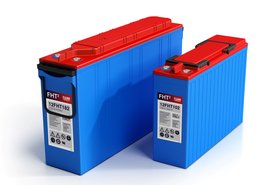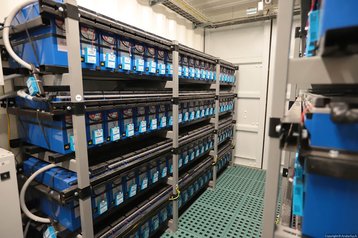Batteries are receiving unprecedented public attention for playing a crucial role in supporting decarbonization in key sectors, such as mobility and energy storage. These applications, among others, need data center support to optimize their performance, helping to maximize return on investment, and reduce energy and critical raw material usage.
Since their introduction, data centers have relied on batteries connected to the UPS system to operate without service outages. The system provides instantaneous energy continuity to support power drawn down from the grid.
Batteries are usually designed to meet short-term needs and maintain power for five to ten minutes. Beyond that time, when support is required for longer, a generator, or other means of power generation like fuel cells, can continue to power the site.
Battery technology options
For decades, VRLA lead batteries have been the most popular option available on the market. Their design has evolved through the years, improving energy density, service life and temperature tolerance.
The last decade has seen the introduction of lithium as an alternative to lead. Lithium offers several advantages: it’s lighter, has a better life cycle, and some designs are more environmentally friendly.
However, it has its drawbacks, too, mainly linked to the inherent instability of lithium which requires proper control and management to remain within safe operational limits.
For this reason, all lithium-based batteries include a battery management system (BMS), which is designed to protect the battery, set off an alert, and disconnect it from the load if any operational parameter exceeds the safety window.
Our recommendations
While initial cost is a major deciding factor, there are other elements that data center operators must consider – technical and purchasing teams evaluate a menu of criteria which add up to the total cost of ownership.
Alongside product performance, delivery, safety, and quality, additional factors to consider now need to include environmental and legislative requirements. Insurance and end of life costs are very different according to battery technology and should be carefully considered.
At FIAMM Energy Technology, we believe that battery safety and reliability should be non-negotiable. Therefore, even in light of recent incidents involving lithium batteries and data center infrastructure damage, we recommend the use of lead-based batteries with flame retardant containers to support UPS systems, and advise the implementation of lithium batteries in hybrid systems where they are supporting grid functions and energy storage.
The latter solution must be installed with proper physical segregation, or better, in a dedicated container separated from the data center’s main facility. Recent accidents have demonstrated how hard it can be to suppress a fire outbreak, if the BMS fails.
Hybrid solutions are an alternative option to consider, with lead batteries providing grid frequency control support, plus back-up functions, and the lithium counterpart providing the energy storage services required by intermittent renewable energy sources.
Lead batteries are recyclable in close loop
All FIAMM batteries are 99 percent recyclable with residual value when disposed of, due to their lead-based construction. The lead inside each product is reprocessed and sent back into the industry to make new batteries. Studies have demonstrated that there is no detrimental performance loss in a new battery that utilises secondary lead material.
European regulations set out that 85 percent of recycled lead should be used for any new batteries introduced to the EU market by 2031, while the target given for lithium is six percent, rising to 12 percent by 2036.
These targets demonstrate the economic and technical challenges in recovering lithium from spent batteries.
FIAMM Energy Technology uses a mixture of primary and recycled lead, with the latter already currently representing 80 percent of all lead used in production plants.
Therefore, not only are we confident in our ability to meet the 85 percent target well before the given deadline, but we can already support data centers in increasing the adoption of products made with recycled materials and aid operators looking to reduce overall environmental impact.
Designing cost-effective and sustainable solutions
Energy is a major expense and key concern for data center operators, with cooling systems utilizing a large proportion of power. FIAMM Energy Technology has developed the FHB and FHT² ranges that reduce these costs by introducing products designed to operate at higher ambient temperatures, lowering cooling needs.
A cost study revealed that an advanced lead acid system designed to operate at elevated temperatures has a lower cooling cost of almost 30 percent in comparison with the equivalent lithium system.
The data center industry is crucial for the development of our society and economy, especially in light of the fact that the demand for AI and data storage is forecasted to grow consistently in the coming years.
At the same time, data center operators need to address their environmental impact by reducing the volume of raw materials and energy required.
FIAMM Energy Technology is providing solutions to help overcome these hurdles, and consistently working with customers to develop increasingly advanced lead-acid batteries that address key challenges and support their decisions, via dedicated case studies.
More from FIAMM Energy Technology
-

Sponsored New European Battery Regulation: Challenges and opportunities for data center players
Discover how the new EU Battery Regulation is reshaping the industry, enforcing CE marking, stricter compliance, and eco-standards
-

Sponsored Fiamm Energy Technology presents the FHT² battery range for high-temperature and peak-shaving operations
After a decade of field experience, research, and tests, Fiamm cranks out a new battery that exceeds different challenges in the data center industry
-

Sponsored Data center batteries: Zero risk of failure through predictive data analytics
According to data center outage surveys, batteries are the Achilles heel of data center power infrastructure. But do they have to be?


